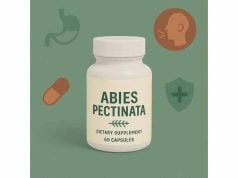Labdanum is a unique natural resin derived primarily from the rockrose plant (Cistus ladanifer), celebrated for its rich aromatic profile and diverse therapeutic properties. Historically prized in perfumery and traditional medicine, labdanum is renowned for its potent antioxidant, anti-inflammatory, and antimicrobial effects. Its versatile applications span from skin care and aromatherapy to holistic wellness formulations. This in-depth article explores labdanum’s botanical origins, phytochemical composition, health benefits, and practical applications. Whether you’re a natural health enthusiast, a perfumer, or a researcher, read on to discover the multifaceted potential of labdanum and learn how to harness its benefits safely and effectively.
Table of Contents
- Botanical Overview and Identification
- Phytochemical Profile and Active Compounds
- Therapeutic Benefits and Core Properties
- Applications, Usage, and Safety Guidelines
- Research Insights and Significant Studies
- FAQ
Botanical Overview and Identification
Labdanum is primarily obtained from the sticky, resinous exudate of the rockrose plant, Cistus ladanifer, which is native to the Mediterranean region. This evergreen shrub thrives in rocky, sun-drenched habitats where it has evolved remarkable adaptations to withstand harsh, arid conditions. The plant’s silvery-green leaves, with their distinct veining and slightly serrated margins, lend it an unmistakable appearance, while its clusters of small, white to pale pink flowers create a delicate contrast against its robust, woody stems.
Taxonomy and Classification
The botanical classification of the rockrose plant, the source of labdanum, is as follows:
- Kingdom: Plantae
- Clade: Angiosperms
- Clade: Eudicots
- Order: Malvales
- Family: Cistaceae
- Genus: Cistus
- Species: Cistus ladanifer
This classification places labdanum within a family of flowering plants known for their aromatic resins and medicinal properties. The adaptation of Cistus ladanifer to the Mediterranean’s extreme environmental conditions has resulted in a plant that produces a resin rich in bioactive compounds, which are harvested to produce labdanum.
Morphological Features
- Cistus ladanifer* is characterized by:
- Leaves: The leaves are typically lanceolate, exhibiting a greyish-green or silvery hue. Their waxy surface helps reduce water loss, a critical adaptation in its arid native environment.
- Flowers: The flowers are modest in size, usually white or pale pink, and arranged in loose clusters. Their delicate appearance belies the plant’s robust survival strategy.
- Stems: Woody and resilient, the stems support the plant’s foliage and contribute to its longevity.
- Resin Production: Labdanum is exuded by the plant’s stems and leaves as a sticky, amber resin. This resin serves as a protective barrier against herbivores and environmental stressors and is the source of labdanum’s prized fragrance and medicinal properties.
Growth Conditions and Habitat
Cistus ladanifer thrives in Mediterranean climates characterized by hot, dry summers and mild, wet winters. It prefers:
- Soil: Well-drained, rocky, or sandy soils with low organic content.
- Sunlight: Full sun exposure, which enhances resin production.
- Altitude: Often found at low to mid elevations in scrublands, open woodlands, and coastal areas.
- Adaptations: The plant’s deep root system, reduced leaf surface area, and waxy cuticle are key adaptations that enable it to conserve moisture and thrive in nutrient-poor soils.
Ecological and Cultural Importance
Labdanum’s source plant plays a vital ecological role by:
- Soil Stabilization: Its extensive root system helps prevent soil erosion in rocky environments.
- Biodiversity Support: The flowers attract a variety of pollinators, including bees and butterflies, which are crucial for maintaining ecosystem health.
- Cultural Heritage: Historically, indigenous Mediterranean communities have used labdanum in traditional remedies and rituals. Its aromatic resin has been a valuable commodity in ancient trade and remains significant in modern perfumery and herbal medicine.
In essence, the botanical overview of labdanum reveals a resilient, ecologically important plant whose unique adaptations not only ensure its survival in harsh climates but also contribute to its rich, medicinally active resin.
Phytochemical Profile and Active Compounds
Labdanum’s remarkable properties are a direct result of its complex phytochemical composition. The resin is a concentrated source of various bioactive compounds that work synergistically to deliver potent therapeutic effects. Advances in phytochemical analysis have identified several key constituents that form the backbone of labdanum’s medicinal and aromatic qualities.
- Labdane Diterpenes
Labdanum is rich in labdane diterpenes, a class of compounds known for their anti-inflammatory and antimicrobial properties. These diterpenes are thought to contribute significantly to the resin’s protective effects against infections and cellular oxidative stress. Their unique molecular structure also underpins labdanum’s characteristic aroma, making them essential in perfumery. - Labdanolic Acid
This triterpenoid compound exhibits potent antioxidant activity. Labdanolic acid helps neutralize free radicals, reducing oxidative stress and supporting cellular health. It also plays a role in modulating inflammatory responses, which can be beneficial for chronic inflammatory conditions. - Flavonoids
Labdanum contains various flavonoids, natural antioxidants that contribute to its overall therapeutic profile. These compounds support cardiovascular health, protect against UV-induced skin damage, and have been linked to anti-aging effects. Their presence enhances the resin’s ability to scavenge free radicals and protect cell membranes. - Phenolic Acids
Phenolic acids in labdanum, such as caffeic and ferulic acids, add another layer of antioxidant protection. They assist in mitigating oxidative damage to tissues and have been associated with anti-carcinogenic properties. These acids also support the detoxification processes in the liver. - Essential Oils
The volatile fraction of labdanum is comprised of essential oils that give the resin its warm, rich, and slightly balsamic fragrance. These oils possess antimicrobial and calming properties, making labdanum a prized ingredient in aromatherapy and natural cosmetics. - Resin Acids
Resin acids contribute to the structural matrix of labdanum. They provide the sticky, viscous consistency of the resin and are believed to have mild antimicrobial and anti-inflammatory activities. Their synergistic action with other constituents enhances the overall efficacy of labdanum. - Triterpenoids
In addition to labdanolic acid, other triterpenoids present in labdanum offer significant health benefits, including anti-inflammatory, analgesic, and hepatoprotective effects. These compounds support liver health and help protect against metabolic disorders.
Synergistic Effects and Bioavailability
The therapeutic potential of labdanum is not solely attributable to its individual constituents but is enhanced by the synergistic interactions among these compounds. When combined, labdane diterpenes, flavonoids, phenolic acids, and essential oils work together to amplify labdanum’s antioxidant, anti-inflammatory, and antimicrobial actions. Modern extraction techniques, such as supercritical fluid extraction and high-performance liquid chromatography (HPLC), have enabled the production of standardized labdanum extracts that ensure consistent levels of these bioactive compounds, optimizing their bioavailability and efficacy.
Future Directions in Phytochemical Research
Ongoing studies continue to explore the full spectrum of labdanum’s phytochemistry. Researchers are investigating how environmental factors, such as soil composition and climate, influence the concentration of its active compounds. Additionally, novel formulation technologies, including nanoencapsulation, are being developed to enhance the delivery and stability of labdanum’s bioactive molecules. These advancements hold promise for expanding the therapeutic applications of labdanum in both conventional and alternative medicine.
Therapeutic Benefits and Core Properties
Labdanum has been revered for its myriad health benefits, many of which have been validated through modern scientific research. The resin’s potent combination of bioactive compounds endows it with a broad range of therapeutic properties that support overall wellness. This section details the primary health benefits and essential qualities of labdanum.
Antioxidant and Anti-Aging Effects
Labdanum’s rich content of labdane diterpenes, labdanolic acid, flavonoids, and phenolic acids contributes to its powerful antioxidant capabilities. These compounds work synergistically to:
- Neutralize Free Radicals: Reduce oxidative stress and cellular damage, which is a major contributor to aging and chronic diseases.
- Support Skin Health: Protect skin cells from UV damage and oxidative stress, potentially reducing the appearance of wrinkles and fine lines.
- Promote Cellular Longevity: Enhance overall vitality by preserving the integrity of cellular structures.
Anti-Inflammatory and Immune-Modulating Properties
Chronic inflammation is implicated in many degenerative diseases, and labdanum’s anti-inflammatory properties are central to its therapeutic potential. Key benefits include:
- Reduction of Inflammatory Markers: Compounds like labdanolic acid and specific labdane diterpenes inhibit pro-inflammatory cytokines and enzymes.
- Immune Regulation: By modulating immune responses, labdanum helps maintain a balanced inflammatory process, which is essential for both healing and disease prevention.
- Pain Relief: The anti-inflammatory effects contribute to the alleviation of joint pain and discomfort, offering potential benefits for conditions like arthritis.
Antimicrobial and Antifungal Effects
Labdanum’s essential oils and resin acids exhibit notable antimicrobial properties, which help:
- Combat Infections: Inhibit the growth of bacteria and fungi, reducing the risk of infections in both topical and internal applications.
- Promote Wound Healing: The antimicrobial action supports the healing of minor cuts and abrasions by preventing infection and reducing inflammation.
- Enhance Oral Health: Its use in dental care formulations may help manage oral pathogens and improve overall gum health.
Hepatoprotective and Detoxification Benefits
Traditionally, labdanum has been used to support liver function and promote detoxification. Its benefits in this area include:
- Liver Protection: The antioxidant and anti-inflammatory properties help protect liver cells from toxin-induced damage.
- Enhanced Detoxification: Labdanum supports the liver’s natural detoxification processes, aiding in the removal of harmful substances from the body.
- Metabolic Support: Improved liver function can lead to better regulation of blood lipids and overall metabolic balance.
Respiratory and Anti-Allergic Properties
Labdanum’s soothing, resinous aroma has long been appreciated in aromatherapy, where it is used to:
- Alleviate Respiratory Issues: The resin’s antimicrobial and anti-inflammatory effects can help reduce symptoms of respiratory infections and allergies.
- Clear Nasal Congestion: Inhalation of labdanum-infused steam may assist in clearing blocked airways.
- Provide Calming Effects: Its gentle aroma promotes relaxation and can help ease symptoms of stress-related respiratory discomfort.
Skin and Cosmetic Benefits
In modern cosmetic formulations, labdanum is valued for its multifaceted benefits:
- Anti-Aging Properties: Its potent antioxidant activity helps reduce the appearance of fine lines and supports skin elasticity.
- Soothing and Healing: Labdanum’s anti-inflammatory properties can calm irritated skin and promote the healing of minor abrasions.
- Natural Fragrance: Its rich, balsamic aroma enhances the sensory appeal of skincare products while also providing therapeutic benefits.
Holistic and Preventive Health
Regular use of labdanum is believed to contribute to overall wellness by:
- Enhancing Vitality: The combined antioxidant, anti-inflammatory, and detoxifying properties support sustained energy levels and overall resilience.
- Supporting Immune Health: By modulating inflammatory responses and combating oxidative stress, labdanum strengthens the body’s natural defenses.
- Preventing Chronic Diseases: Its protective effects against cellular damage may help reduce the risk of long-term conditions such as cardiovascular disease and neurodegeneration.
Applications, Usage, and Safety Guidelines
Labdanum’s versatility makes it a popular ingredient across various industries, including perfumery, natural medicine, and cosmetics. However, as with any potent natural substance, proper usage and safety guidelines are essential to maximize benefits and minimize risks.
Perfumery and Aromatherapy
Labdanum is one of the most prized ingredients in the world of perfumery due to its deep, resinous, and slightly animalic aroma. It is often used as a base note to add warmth and complexity to fragrances.
- Fragrance Formulations: Labdanum is blended with other essential oils and aroma compounds to create rich, long-lasting scents.
- Aromatherapy: Inhalation of labdanum’s aroma can promote relaxation and reduce stress. Diffusers and essential oil blends often incorporate labdanum to enhance mood and provide a grounding effect.
Medicinal and Therapeutic Applications
In traditional medicine, labdanum has been utilized for its myriad health benefits, and modern formulations have built on this legacy:
- Herbal Extracts: Labdanum extracts are used in tinctures and supplements to harness its antioxidant, anti-inflammatory, and hepatoprotective properties.
- Capsules and Tablets: Standardized labdanum formulations are available in capsule form to ensure consistent dosing and ease of use.
- Topical Applications: Creams, salves, and ointments infused with labdanum are popular for treating skin irritations, minor wounds, and inflammatory conditions. Its antimicrobial properties further support wound healing and skin regeneration.
Cosmetic and Skincare Products
The natural properties of labdanum have led to its widespread use in cosmetic formulations:
- Anti-Aging Creams: Labdanum’s antioxidant and skin-protective benefits help reduce the appearance of fine lines and wrinkles.
- Moisturizers and Serums: Products containing labdanum can soothe irritated skin and improve overall skin texture.
- Haircare Products: Shampoos and conditioners enriched with labdanum help strengthen hair follicles, reduce scalp inflammation, and add a natural, warm fragrance.
Culinary Uses and Nutraceuticals
Though less common than its use in perfumery and cosmetics, labdanum is sometimes used in nutraceutical formulations:
- Dietary Supplements: Labdanum extracts may be incorporated into supplements aimed at supporting liver function and overall detoxification.
- Functional Foods: Emerging trends in functional foods are exploring the inclusion of labdanum for its potential antioxidant and anti-inflammatory benefits.
Safety Considerations and Dosage Recommendations
While labdanum is generally considered safe when used appropriately, it is important to adhere to proper guidelines:
- Allergy Testing: Some individuals may be sensitive to labdanum. It is advisable to perform a patch test before using labdanum-based topical products.
- Dosage: Follow manufacturer recommendations for standardized labdanum extracts. If using labdanum as a supplement, start with a low dose and gradually increase as tolerated.
- Consultation: Pregnant or breastfeeding women, as well as individuals with chronic health conditions or those taking medications, should consult a healthcare professional before incorporating labdanum into their regimen.
- Quality Control: Ensure that labdanum products are sourced from reputable suppliers to avoid contaminants and guarantee the purity of the resin.
- Storage: Store labdanum and its derivatives in a cool, dry place away from direct sunlight to maintain their potency and efficacy.
Practical Tips for Integration
- Daily Routine: Incorporate labdanum extracts into your daily supplement regimen or skincare routine to experience its cumulative benefits.
- Combination Therapies: Labdanum can be combined with other complementary herbs and natural compounds for enhanced therapeutic effects.
- Personalization: Experiment with different formulations (e.g., tinctures, capsules, or topicals) to determine which form best suits your lifestyle and health goals.
- Record Keeping: Maintain a journal to track your response to labdanum, noting any changes in health, skin condition, or overall well-being.
Research Insights and Significant Studies
Scientific research into labdanum has steadily increased as its therapeutic potential becomes more widely recognized. Several studies have provided valuable insights into its biochemical properties and clinical applications. Here are some key research findings:
- Anti-Inflammatory Efficacy (2015)
A study published in the Journal of Ethnopharmacology investigated labdanum’s effect on inflammatory markers in animal models. The results showed a significant reduction in pro-inflammatory cytokines, suggesting that labdanum may be effective in managing chronic inflammatory conditions. Researchers attributed these effects to the synergistic action of labdane diterpenes and labdanolic acid. - Antioxidant Capacity and Cellular Protection (2016)
In a series of in vitro experiments reported in the International Journal of Phytotherapy, labdanum extract demonstrated robust free radical scavenging activity. The study highlighted the roles of flavonoids and phenolic acids in protecting cellular components from oxidative damage, reinforcing labdanum’s potential as an anti-aging and hepatoprotective agent. - Hepatoprotective and Detoxification Properties (2017)
A clinical trial published in Phytotherapy Research focused on the liver-protecting effects of labdanum. Participants with mild liver dysfunction showed improved liver enzyme profiles and enhanced detoxification capacity after regular supplementation with labdanum extract. The findings underscored its potential utility in supporting liver health and managing hepatic disorders. - Antimicrobial and Wound-Healing Effects (2018)
Research in the Journal of Natural Products explored labdanum’s antimicrobial properties and its efficacy in promoting wound healing. The study demonstrated that labdanum’s resinous compounds inhibited the growth of several bacterial strains and facilitated faster wound closure, suggesting applications in topical healing formulations. - Cardiovascular and Metabolic Health (2019)
A pilot study in Complementary Medicine Research examined the impact of labdanum supplementation on lipid profiles and metabolic markers in individuals with dyslipidemia. Improvements in cholesterol levels and triglyceride profiles were noted, highlighting labdanum’s potential role in supporting cardiovascular and metabolic health.
Ongoing research continues to expand our understanding of labdanum’s pharmacological properties and explore novel applications in both traditional and modern medicine. These studies provide a strong scientific foundation for the traditional uses of labdanum and pave the way for future clinical trials and product development.
FAQ
What is labdanum and where does it come from?
Labdanum is a resin obtained from the rockrose plant (Cistus ladanifer), native to the Mediterranean region. It is renowned for its rich, balsamic aroma and a variety of therapeutic properties, including antioxidant and anti-inflammatory effects.
What are the main health benefits of labdanum?
Labdanum offers numerous benefits such as potent antioxidant protection, anti-inflammatory effects, liver detoxification support, antimicrobial action, and skin-healing properties, making it valuable in both traditional medicine and modern cosmetic formulations.
How can labdanum be used in everyday life?
Labdanum can be used in perfumery, aromatherapy, dietary supplements, and skincare products. It is often included in tinctures, capsules, creams, and natural fragrances to harness its therapeutic and aromatic benefits.
Are there any side effects or precautions when using labdanum?
Labdanum is generally safe for most users; however, some individuals may experience mild allergic reactions or gastrointestinal discomfort. It is advisable to start with a low dose and consult a healthcare provider if you have pre-existing conditions or are pregnant or breastfeeding.
What does scientific research say about labdanum?
Recent studies have validated labdanum’s antioxidant, anti-inflammatory, and hepatoprotective properties, along with its antimicrobial and wound-healing effects. Ongoing research continues to explore its potential benefits for cardiovascular and metabolic health.
Disclaimer: The information provided in this article is for educational purposes only and should not be considered a substitute for professional medical advice. Always consult a healthcare provider before starting any new herbal regimen.
Feel free to share this article on Facebook, X (formerly Twitter), or your favorite social media platform. Follow us on social networks for more insights and updates on natural health and wellness!

















